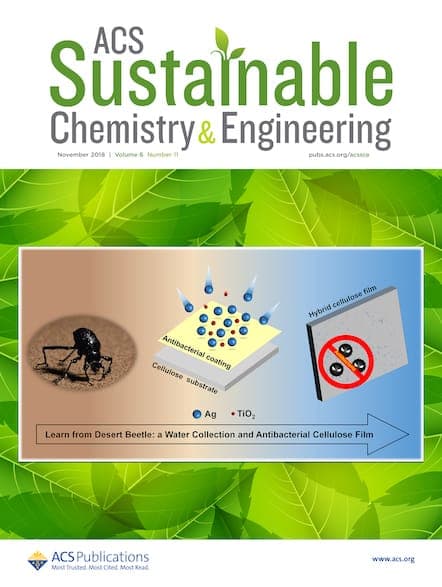The 2020 ACS Sustainable Chemistry & Engineering Lectureship Awards recognize the research contributions of scientists in three geographical regions, working in green chemistry, green engineering, and sustainability in the chemical enterprise.

The Editors of ACS Sustainable Chemistry & Engineering and the ACS Green Chemistry Institute are delighted to announce the three winners of the 2020 ACS Sustainable Chemistry & Engineering Lectureship Awards. These awards recognize the research contributions of scientists in three geographical regions, working in green chemistry, green engineering, and sustainability in the chemical enterprise, who have completed their academic training within the past ten years. Lectureship award-winners are selected for three regions: The Americas, Europe/Middle East/Africa, and Asia/Pacific.
Professor Katalin Barta, University of Graz

Representing the Europe/Middle East/Africa region, Professor Katalin Barta of the University of Graz (Graz, Austria), is being honored for the development of sustainable catalytic solutions for lignin depolymerization and the valorization of lignocellulosic biomass.
What will you be presenting at the conference?
I will be presenting how, in the past few years, our attempts to ‘tame’ or tackle the complexity of lignocellulose and how we tried to gain more understanding about this interesting material. As I will show, it can serve as a good source for fuels, building blocks, and even biologically active molecules.
How have the COVID-19 shutdowns and restrictions changed the way you and your lab members work together and approach your research?
It was a particularly challenging situation as my lab was in the middle of a move from the University of Groningen to the University of Graz. One half of the group just arrived in Graz and went to a lockdown straight away – we did not even manage to unpack our boxes properly. The other half of the lab got stuck in Groningen, not knowing exactly when they can move. All this, plus two small children at home, inspired sufficient creativity in our ‘scientific methods.’ For example, instead of set meeting times, I frequently called my Ph.D. students or post-docs when I was out in the garden playing with my son or while cooking lunch or dinner. I hope all of this experience will bring us even closer as a group, and we will appreciate the little things in our everyday lab life when the group will be finally reunited. I also gave my coworkers the advice to use this time of isolation to look deeply into their research, read, read, read, and don’t search for answers. Rather, try to find fascinating research questions!
What type of work can we look forward to seeing from you in the future?
I hope my group will surprise me with all those great ideas they had during this shutdown. So, we will work on those and see where research takes us.
***
Professor Feng Wang, Dalian Institute of Chemical Physics

Representing the Asia/Pacific region, Professor Feng Wang, of Dalian Institute of Chemical Physics (Dalian, China), is being honored for the deployment of sustainable catalysis and photocatalytic methods to selectively transform biomass and its derivatives into oxygenated platform chemicals.
What will you be presenting at the conference?
I will present our recent work on the photocatalytic conversion of biomass and its derivatives to several kinds of valuable products, such as methanol, syngas, alkane, and diesel precursors. I will discuss the underlying reaction mechanism of photocatalysis.
How have the COVID-19 shutdowns and restrictions changed the way you and your lab members work together and approach your research?
The pandemic postponed the lab member’s return. All on-site scientific meetings in the past four months have been canceled. Some of the meetings have been moved online, as well as our weekly group meetings.
What type of work can we look forward to seeing from you in the future?
We are now working on more efficient catalysts and new methods of converting biomass to chemicals. This work will combine biocatalysts and heterogeneous catalysts together to realize pretreatment and conversion in a harmonious way.
***
Professor Jonas Baltrusaitis, Lehigh University

Representing the Americas region, Professor Jonas Baltrusaitis of Lehigh University (Bethlehem, Pennsylvania, USA), is being honored for applying the varied concepts of sustainable chemistry and engineering, particularly in the fields of advanced materials science and supramolecular chemistry, to the delivery of more sustainable fertilizers and nutrients
What will you be presenting at the conference?
Managing the nitrogen cycle is one of the 14 Grand Challenges for engineering in the 21st century, as put forth by the National Academy of Engineering. My presentation will focus on describing this challenge in terms of its uniqueness, how it differs from, say other food/energy//water related global challenges, such as managing phosphorus cycle and presenting examples from my research group work geared towards mitigating it.
How have the COVID-19 shutdowns and restrictions changed the way you and your lab members work together and approach your research?
It made us reconsider the scope of our work. While the research in my lab relies heavily on complex instrumentation, such as Raman and infrared spectroscopy, we analyzed the literature and identified specific areas where we need to advance the molecular modeling. We use it to interpret our spectroscopic data as well as establishing previously hypothesized surface structures of urea cocrystals as well as some heterogeneous catalysts we use. By doing so, graduate students had an opportunity to explore new concepts, such as density functional theory, as well as to analyze their data from the thermodynamic and kinetic perspectives. The current work has been funded by NSF Chemistry and resulted in a series of publications elucidating the pathways of low mineral surface chemistry during aqueous ammonium and phosphate ion adsorption.
What type of work can we look forward to seeing from you in the future?
Thank you for the opportunity to reflect on this. I have always aimed to identify problems of global significance and tailored the work performed in my group accordingly. In the past few years, I have been conceptualizing ways to paradigmatically change the global nitrogen cycle, which is the source of tremendous energy consumption and atmospheric and watershed pollution. This is by no means an easy task. Currently, only about 50% of the applied urea nitrogen is absorbed by the plants unless synthetic organophosphorus compounds – urease inhibitors – are utilized to decrease the hydrolysis rate of urea.
Urease inhibitors have a rather short half-life (~4 days) in the environment and result in negative environmental effects such as leaf-tip necrosis or limited capacity of plants to utilize urea as an N-source. They have added costs to farmers while, most importantly, being a source of synthetic organophosphorus compounds to the environment and possessing potential toxicity effects (such as reproductive hazard, as inferred from MSDS of N-(n-butyl)-thiophosphoric triamide). We propose engineering organophosphorus-free urea cocrystals using a solvent-free sustainable mechanochemical synthesis and quantifying the resulting nitrogen gas emissions, nitrogen partitioning into the soil (longevity/stability therein), and plants.
The proposed work would: (a) utilize natural minerals, such as gypsum, calcite, magnesite, dolomite, and others to also deliver other macro and micronutrients necessary for the plants and (b) utilize other widely available inorganic salts (chlorides, nitrates, sulfates, and hydrophosphates) to encapsulate urea in these molecular crystals.
As is typical to our lab, we will utilize a combination of the in situ molecular spectroscopy and quantum chemical calculations trying to understand how and why certain urea cocrystals are more stable in the environment while also synthesizing new ones and elucidating their crystal structure. This fascinating research very recently was recommended for funding by USDA NIFA, for which we are grateful.
***
